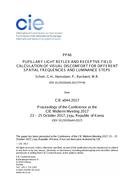Click here to purchase
Light sources causing annoyance or pain produce discomfort glare. Traditional glare metrics are merely empirical and fail for non-uniform luminaires. By incorporating the centre-surround receptive field mechanism, the pupillary light reflex and a position index correction per pixel, a more physiologically justified model is developed. The centre-surround receptive field mechanism acts similar to an edge filter and represents the visual signal. The pupil area, influences the retinal illuminance. A correction according to the Guth position index accounts for the reduction in brightness perception when a light source is moved away from the line of sight. The model is analysed with a paired comparison experiment involving 9 non-uniform rear projected stimuli with different spatial frequencies and luminance steps. With a coefficient of determination of 0.90, the model is a promising alternative to current glare metrics, especially when non-uniform luminaires are to be evaluated.
Product Details
- Published:
- 10/23/2017
- Number of Pages:
- 11
- File Size:
- 1 file , 1.5 MB
